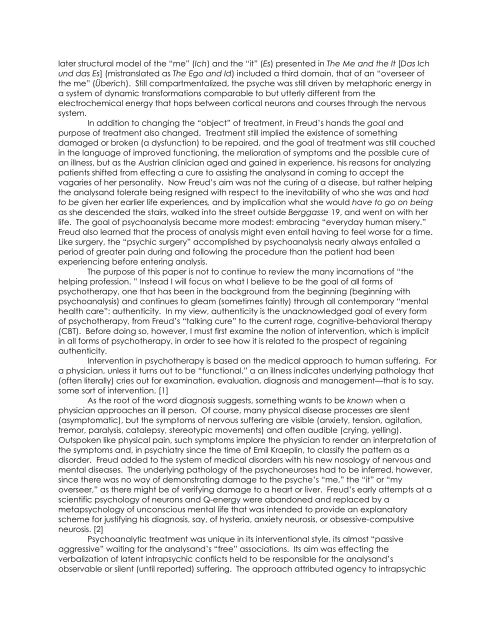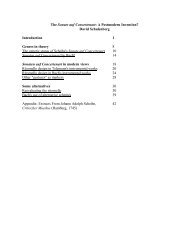SEVEN PAPERS ON EXISTENTIAL ANALYSIS ... - Wagner College
SEVEN PAPERS ON EXISTENTIAL ANALYSIS ... - Wagner College
SEVEN PAPERS ON EXISTENTIAL ANALYSIS ... - Wagner College
Create successful ePaper yourself
Turn your PDF publications into a flip-book with our unique Google optimized e-Paper software.
later structural model of the “me” (Ich) and the “it” (Es) presented in The Me and the It [Das Ich<br />
und das Es] (mistranslated as The Ego and Id) included a third domain, that of an “overseer of<br />
the me” (Überich). Still compartmentalized, the psyche was still driven by metaphoric energy in<br />
a system of dynamic transformations comparable to but utterly different from the<br />
electrochemical energy that hops between cortical neurons and courses through the nervous<br />
system.<br />
In addition to changing the “object” of treatment, in Freud’s hands the goal and<br />
purpose of treatment also changed. Treatment still implied the existence of something<br />
damaged or broken (a dysfunction) to be repaired, and the goal of treatment was still couched<br />
in the language of improved functioning, the melioration of symptoms and the possible cure of<br />
an illness, but as the Austrian clinician aged and gained in experience, his reasons for analyzing<br />
patients shifted from effecting a cure to assisting the analysand in coming to accept the<br />
vagaries of her personality. Now Freud’s aim was not the curing of a disease, but rather helping<br />
the analysand tolerate being resigned with respect to the inevitability of who she was and had<br />
to be given her earlier life experiences, and by implication what she would have to go on being<br />
as she descended the stairs, walked into the street outside Berggasse 19, and went on with her<br />
life. The goal of psychoanalysis became more modest: embracing “everyday human misery.”<br />
Freud also learned that the process of analysis might even entail having to feel worse for a time.<br />
Like surgery, the “psychic surgery” accomplished by psychoanalysis nearly always entailed a<br />
period of greater pain during and following the procedure than the patient had been<br />
experiencing before entering analysis.<br />
The purpose of this paper is not to continue to review the many incarnations of “the<br />
helping profession. ” Instead I will focus on what I believe to be the goal of all forms of<br />
psychotherapy, one that has been in the background from the beginning (beginning with<br />
psychoanalysis) and continues to gleam (sometimes faintly) through all contemporary “mental<br />
health care”: authenticity. In my view, authenticity is the unacknowledged goal of every form<br />
of psychotherapy, from Freud’s “talking cure” to the current rage, cognitive-behavioral therapy<br />
(CBT). Before doing so, however, I must first examine the notion of intervention, which is implicit<br />
in all forms of psychotherapy, in order to see how it is related to the prospect of regaining<br />
authenticity.<br />
Intervention in psychotherapy is based on the medical approach to human suffering. For<br />
a physician, unless it turns out to be “functional,” a an illness indicates underlying pathology that<br />
(often literally) cries out for examination, evaluation, diagnosis and management—that is to say,<br />
some sort of intervention. [1]<br />
As the root of the word diagnosis suggests, something wants to be known when a<br />
physician approaches an ill person. Of course, many physical disease processes are silent<br />
(asymptomatic), but the symptoms of nervous suffering are visible (anxiety, tension, agitation,<br />
tremor, paralysis, catalepsy, stereotypic movements) and often audible (crying, yelling).<br />
Outspoken like physical pain, such symptoms implore the physician to render an interpretation of<br />
the symptoms and, in psychiatry since the time of Emil Kraeplin, to classify the pattern as a<br />
disorder. Freud added to the system of medical disorders with his new nosology of nervous and<br />
mental diseases. The underlying pathology of the psychoneuroses had to be inferred, however,<br />
since there was no way of demonstrating damage to the psyche’s “me,” the “it” or “my<br />
overseer,” as there might be of verifying damage to a heart or liver. Freud’s early attempts at a<br />
scientific psychology of neurons and Q-energy were abandoned and replaced by a<br />
metapsychology of unconscious mental life that was intended to provide an explanatory<br />
scheme for justifying his diagnosis, say, of hysteria, anxiety neurosis, or obsessive-compulsive<br />
neurosis. [2]<br />
Psychoanalytic treatment was unique in its interventional style, its almost “passive<br />
aggressive” waiting for the analysand’s “free” associations. Its aim was effecting the<br />
verbalization of latent intrapsychic conflicts held to be responsible for the analysand’s<br />
observable or silent (until reported) suffering. The approach attributed agency to intrapsychic















